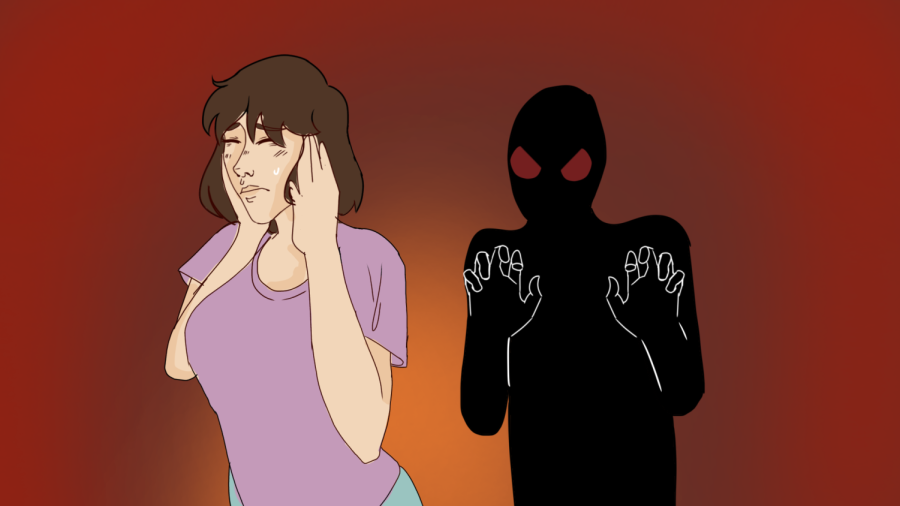[Opinion] Horror films enforce stereotypical representations of women
Lilliana Griffis
A woman acts timid, rather than fighting back, exemplifying a common stereotype in horror movies. Though in more modern films these stereotypes haven’t appeared as often.
February 15, 2023
Horror films are notorious for embracing gender stereotypes and continuously reinforcing them throughout their duration. This resort to such outdated principles is especially apparent when it comes to female characters, as they often appear in cliché and tired roles, playing into overdone tropes.
One common phenomenon in the horror genre is reducing a woman’s voice to the sound of a scream. Chilling screams are a staple of the horror genre, contributing tension to their sinister atmosphere. Yet, these screams are rarely delivered by men, instead produced by terror-stricken women. Furthermore, these women are made out to be fragile, docile and timid, displaying fear as their sole emotion; their only means by which to convey it being a scream. Yet, having a woman scream is not inherently problematic. It is their excessive use that makes them so, as their continuous occurrence is what causes stereotypes to prevail.
Furthermore, in horror movies there has proven to be a trend in which the first character killed is a promiscuous woman. Regardless of how this is intended, it often comes off as if her death is punishment for her actions. Further enforcing this implication is another frequent trope, in which women have sex and are subsequently killed. Prominent movies that feature this plotline include ‘Halloween,’ ‘Friday the 13th,’ ‘A Nightmare on Elm Street’ and ‘The Texas Chainsaw Massacre.’
Going hand in hand with the previous trope, is the standard female role of the final girl, the only heroine left alive at the end of a film. The woman who fulfills this role is often pure, directly contrasting the nature of those that are killed. Films that utilize this trope were praised in the past for showing a woman holding her own against a killer, but modern standards have brought about a different view on the subject altogether. Now, instead of being praised for this, they are being condemned for placing the untainted woman on a pedestal, while punishing her experimental counterparts.
However, more recent films have made a greater effort to subvert such stereotypes. One example of this is ‘Scream,’ which makes an outright mockery of the trope. At one point in the film, a character even details the rules one must follow to survive a horror movie. In doing so, he states the first to be that “You can never have sex… Sex equals death.” Moving forward, horror films as of late, appear to be disregarding the idea of an innocent final girl altogether, with the perfect example of its abandonment being the A24 film ‘X.’ This movie’s final girl, Maxine, is starring in an adult film in which she relies on her body and youth to obtain fame.
Moreover, many horror films also portray females perversely, not only victimizing them, but sexualizing them as well. The distinguished Molitor and Sapolsky study, a content analysis that compared popular slasher films released in the 1990s to similar ones released in the 1980s, proved that while men are often killed instantaneously, women take twice as long to die on screen. This time permits cameras to capture her trying to escape or pan her body, as viewers watch her slow, sexualized death. This is further aggravated by the fact that in many cases, such deaths are filmed using close-ups of women and subjective angles, placing them in a to be looked at position, which works to evoke visual pleasure from an audience.
Delving further into this notion, is the continuous exploitation and violation of the female body in horror films. The most obvious example of this is a scene in ‘The Nightmare on Elm Street,’ in which one of the characters, Nancy, falls asleep in the bathtub. The audience is not made aware of the fact that she is dreaming, until the villain’s hand rises up between her open legs. The point of this scene is clear and its symbolism is undeniable.
Then, there is the girlhood to monster trope, in which puberty appears to make monsters out of priorly innocent girls. The transition is depicted as something grotesque, and its result is the woman becoming the antagonist, with her femininity being villainized. This can be seen in the movie ‘Carrie,’ which features the main character’s unraveling, beginning with when she gets her period for the first time. This event is then made out to be what prompted the occurrences of the rest of the film and set in motion Carrie’s ultimate demise.
Nevertheless, an increasing number of horror films have begun to feature strong female protagonists. These protagonists are often being held back by an element of patriarchal society and are confined to a claustrophobic environment. These types of films are considered elevated horror, due to their commentary on social issues and society. Therefore, the women will inevitably seek autonomy, with its achievement being the climax of the film. Movies such as ‘Midsommar’ and ‘The Witch’ are among those that feature this plotline.
Yet, also common today, is the character of the woman who harms those who have wronged her. This is where the good for her mentality comes from, watching someone enact vengeance upon those they have suffered at the hands of. With this character, it often doesn’t matter what measures are taken in achieving retribution, as she still manages to gain the validation and approval of an audience. Both the A24 films ‘X’ and ‘Pearl,’ along with ‘Jennifer’s Body,’ portray this character exceptionally well.
Despite horror being a dependable genre when it comes to the use of gendered stereotypes and outdated biases, it will hopefully continue its movement away from such tired phenomenons. Fortunately, there are already directors out there, such as Ari Aster, Jordan Peele and Ti West, helping to do just that and with luck, there will be many more striving to do the same.










